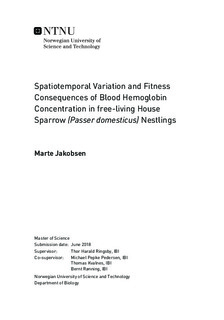| dc.description.abstract | Studies have suggested that variation in hemoglobin concentration among individuals can be used as an indicator of individual condition as it reflects the amount of oxygen that is supplied to the tissues. Thus, it is important to examine the factors that causes this variation, as well as the fitness consequences of the individual variation in hemoglobin concentration. In this study, different factors influencing the variation in hemoglobin concentration of 11-day-old house sparrow (Passer domesticus) nestlings were investigated in a metapopulation in northern Norway. The central findings in the study were: (i) variation in nestling hemoglobin concentration was related to the individuals stage of maturation, i.e. age and body mass, (ii) there was a positive effect of precipitation on the hemoglobin concentration, which was most pronounced in nestlings of low body mass, (iii) brood number had an influence on hemoglobin concentration, where nestlings in the second brood had a significant lower hemoglobin concentration compared to the first brood, and (iv) hemoglobin concentration did not significantly explain nestling mortality from 5-day age to fledging stage. These findings demonstrate that hemoglobin concentration reflects nestling s physiological stage of development, as the concentration was found to be highly correlated to both age and body mass. Altricial birds depend on substantial parental care, and the variation in average hemoglobin concentration among broods may indicate that the parents invested differently in the broods. Alternatively, the differences among broods could be explained by variations in the food availability during the breeding season, but this was not supported by the results as hatching day did not explain the variation in hemoglobin concentration. | |

